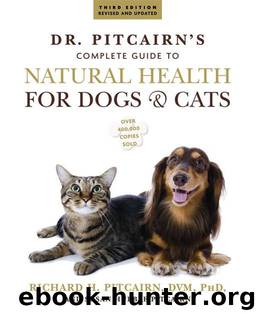Dr. Pitcairn's Complete Guide to Natural Health for Dogs and Cats by Richard H. Pitcairn & Susan Hubble Pitcairn

Author:Richard H. Pitcairn & Susan Hubble Pitcairn [Pitcairn, Richard H. & Pitcairn, Susan Hubble]
Language: eng
Format: epub
Tags: General, Dogs, Pets, pet health, cats
ISBN: 9781594869259
Google: HysLC73zLHwC
Publisher: Rodale
Published: 2005-09-02T16:00:00+00:00
The extensive use of antibiotics.
The commonplace use of anti-inflammatory drugs like cortisone.
The frequent use of vaccines.
These things were simply not done before. The antibiotic era began in 1928 with Alexander Fleming’s discovery of penicillin. During the last few decades, however, so many more antibiotics have been developed and used.
In 1948, Edward C. Kendall and Philip S. Hench tried out cortisone on patients suffering from rheumatoid arthritis. This is a hormone secreted by the adrenal gland. By harvesting it and trying it out on patients, they found that it reduced inflammation in the body. This marked the beginning of a new practice of medicine, one based on suppression of symptoms as a routine approach. As time went on, a family of powerful synthetic forms of cortisone were created, drugs acting 10 or 20 times more powerfully than the version the body produces. This group of drugs, called cortico-steroids, is very commonly used in medicine today.
Vaccines started with Edward Jenner, who initiated smallpox vaccination in the 18th century. But this did not really develop into the multiplicity of vaccinations used today until the 20th century.
From these humble beginnings, we have the origin of the modern system of medicine that is based on the tripod of antibiotics, anti-inflammatory drugs, and vaccines. All of these have effects on the immune system and, at least to my mind, are the culprits in what has gone wrong with the immune system. I believe it is simply too much.
Based on these ideas, I advise my clients to avoid these treatments as much as possible. Certainly there is a place for antibiotics and other drugs. I even agree that some vaccines are appropriate. My objection is the indiscriminate use of them. I don’t think I exaggerate in saying that almost any time your animal is sick, he or she will likely be put on antibiotics and steroids. This is the “standard of practice” for veterinary medicine today. In this chapter and the latter part of this book, I will introduce some equally effective alternatives to this, other ways of treating illness that do not have this harmful impact on the immune system.
MISSING NUTRIENTS
Our last category has to do with a lack of necessary vitamins, minerals, proteins, and other food nutrients that are necessary for the immune system to work and for body tissues to be able to regenerate themselves. The human body contains a total of 100 trillion cells, the blood cells alone numbering 25 trillion. These numbers are so large that I can’t grasp them myself, but here is a comparison that helps a little. The Milky Way galaxy is estimated to contain one hundred billion stars, only one percent of the number of cells found in our bodies. Yet this immense number of cells is constantly being regenerated, as old ones die and new ones take their place. Over a number of months or years, depending on the part of the body, everything is replaced, even the DNA that makes up our genetic code.
Realizing this, we can see how dynamic our biological structures are—going through continual repair and renewal.
Download
This site does not store any files on its server. We only index and link to content provided by other sites. Please contact the content providers to delete copyright contents if any and email us, we'll remove relevant links or contents immediately.
Finding Gobi by Dion Leonard(2260)
Grumpy Cat by Grumpy Cat(2121)
The Silkworm by Robert Galbraith(1999)
A New Earth: Awakening to Your Life's Purpose by Eckhart Tolle(1974)
End of Days by Sylvia Browne(1824)
Tippi by Tippi Hedren(1766)
Total Cat Mojo by Jackson Galaxy(1688)
Backyard Chickens Beyond the Basics by Pam Freeman(1618)
The Animals Among Us by John Bradshaw(1509)
The Ultimate Pet Health Guide by Gary Richter(1431)
Vet in Harness by James Herriot(1387)
Cesar's Way by Cesar Millan(1366)
Dog Years by Mark Doty(1365)
Doggy Desserts: 125 Homemade Treats for Happy, Healthy Dogs by Cheryl Gianfrancesco(1360)
All Things Bright and Beautiful by James Herriot(1304)
Chicken Soup for the Ocean Lover's Soul by Jack Canfield(1289)
Walking with Peety by Eric O'Grey(1286)
Dog Training 101 by Kyra Sundance(1262)
Encyclopedia of Dog Breeds by D. Caroline Coile Ph.D(1178)
